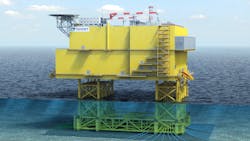Petrofac, Hitachi Energy ink landmark offshore wind framework agreement
Offshore staff
LONDON — Petrofac and Hitachi Energy have been selected by TenneT to supply multiple offshore platforms and onshore converter stations to accelerate the integration of bulk renewables into European power grids.
Petrofac and Hitachi Energy were awarded the multi-year framework agreement, worth about 13 billion euros (US$14.1 billion), as part of TenneT’s 2-GW high-voltage direct current (HVDC) offshore wind program.
The agreement includes an initial commitment to deploy six record-breaking renewable integration systems, five of which will connect offshore wind farms to the Dutch grid and the sixth to the German grid. Each of these connection systems has a capacity of 2 GW and a voltage level of 525 kilovolt, which the partners say is a world-first for offshore wind.
The landmark framework agreement represents the largest in Petrofac’s history. It enables Petrofac and Hitachi Energy to plan in advance, secure the required resources and yard space as well as capture synergies between successive projects to meet in-service dates.
Petrofac will undertake the engineering, procurement, construction and installation of the offshore platforms and elements of the onshore converter stations. Hitachi Energy will supply its HVDC Light converter stations, which convert AC to DC power offshore and DC to AC onshore.
The first contract under the framework, for the Ijmuiden Ver Alpha project, was awarded with immediate effect. The second, Nederwiek 1, is expected to be awarded later in the year. The framework also includes projects Doordewind 1, Doordewind 2, Nederwiek 3 and LanWin5, expected to be awarded over a 2024-2026 timeframe.
Petrofac and Hitachi Energy began working together in June 2022 to provide joint grid integration and associated infrastructure solutions to support TenneT’s 2-GW program. In the same year, Germany, the Netherlands, Denmark and Belgium agreed to install at least 65 GW of offshore wind energy combined by 2030, as announced with the inter-governmental Esbjerg Declaration. At 40 GW, almost two-thirds of this capacity is accounted for by TenneT, with 20 GW each in the German and Dutch North Sea sectors.
03.30.2023
